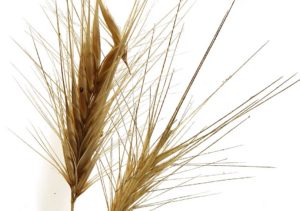 Your pet has a deadly enemy that comes in the form of several species of grassy weeds that grow rapidly during the winter/spring rains. When these grasses mature a seed forms at the top of the stalk resembling a fox tail.
Your pet has a deadly enemy that comes in the form of several species of grassy weeds that grow rapidly during the winter/spring rains. When these grasses mature a seed forms at the top of the stalk resembling a fox tail.
Once foxtail grasses dry out, the seed detaches easily and sticks readily to clothing and fur. Foxtail seeds can enter a dog’s body in a variety of ways and once in they act like a fishhook burrowing inward; and because of tiny barbs, it cannot back out on its own.
It’s most common for a foxtail to enter a dog’s body through the skin, nose, ears, paws, genitals and eyes. One veterinarian reported that a foxtail found in a dog’s lung initially entered through the dog’s paw. Foxtails are tenacious and deadly.
 Foxtail seeds are relatively small, so detecting them after they enter a dog’s body can be difficult. Veterinarians usually rely on telltale symptoms such as head-shaking, paw licking, swellings on the body, or sudden and continuous sneezing. Foxtails in the ears, nose and eyes are serious and can ultimately be life-threatening if not treated promptly.
Foxtail seeds are relatively small, so detecting them after they enter a dog’s body can be difficult. Veterinarians usually rely on telltale symptoms such as head-shaking, paw licking, swellings on the body, or sudden and continuous sneezing. Foxtails in the ears, nose and eyes are serious and can ultimately be life-threatening if not treated promptly.
When a foxtail is inhaled and lodged in the nasal cavity, a dog will sneeze repeatedly and violently, sometimes even banging his nose on the floor in a futile attempt to dislodge the seed. It is often possible for a veterinarian to sedate the animal, locate the seed with an otoscope and remove it using special forceps if the animal is brought in when symptoms first appear.
If a foxtail is lodged in the paw or under the coat, a lump will usually form that is painful to touch. Depending on how deep the foxtail has traveled it can usually be removed surgically.
When a foxtail gets into a dog’s eye, the dog will paw at the eye. When you see a foxtail under the eyelid don’t try to remove it – you may not get it all. Keep your dog from pawing the eye and get him to a veterinarian immediately, preferably a veterinary ophthalmologist.
When your dog gets a foxtail in an ear, he will usually shake his head violently. Whenever you suspect a foxtail, get your dog to a veterinarian immediately. The best way to handle foxtail problems is to prevent them or treat them early.
Whenever possible avoid foxtail infested areas – especially during the dry season. But after a romp through tall, mature grass follow these steps:
- Thoroughly brush and inspect your dog’s coat. Run your hands over his coat looking for foxtails. Dogs with long hair are particularly susceptible to foxtails.
- Look into your dog’s ears. If your dog has floppy ears, lift each ear and inspect.
- Examine your dog’s paws (in-between toes and paw pads), neck (under the collar), tail/anus, and under leg areas after walks in areas with foxtails. Remove any foxtails sitting on the fur.
- If you believe your dog has a foxtail lodged somewhere in his body, get him to a veterinarian immediately. The longer you wait, the deeper the foxtail will travel and the more damage it will do, and the more difficult it will be to treat.
Learn to recognize foxtails and avoid them! Foxtail danger in our parks, yards, empty lots and alleys can be greatly reduced by simply mowing the grass regularly, especially in the late spring. Mowing cuts off the foxtail grass before the deadly seed forms.
Source: Foxtail season deadly threat to pets
